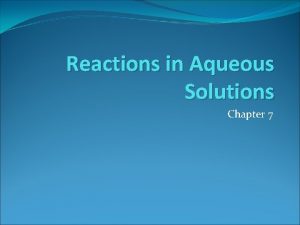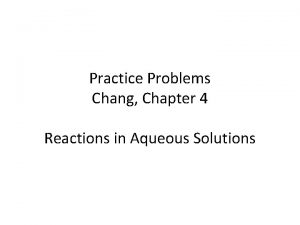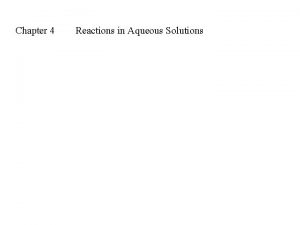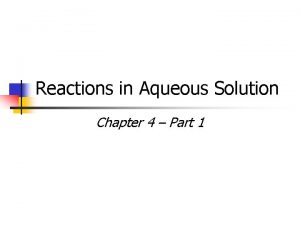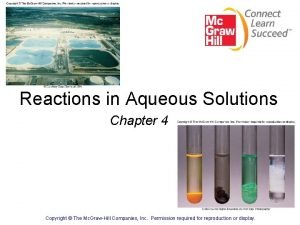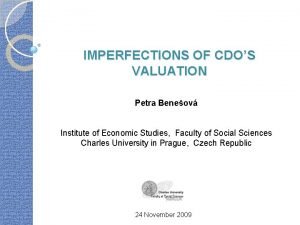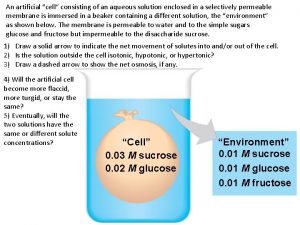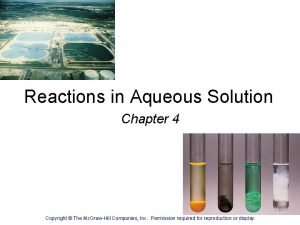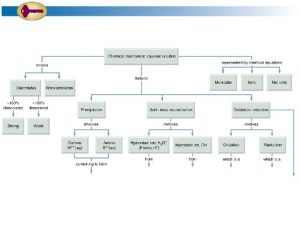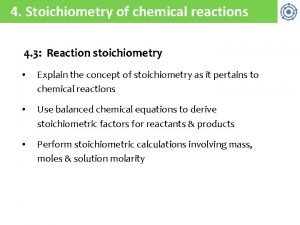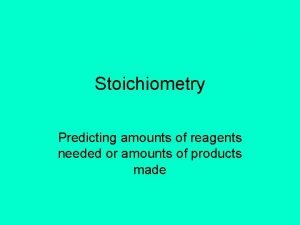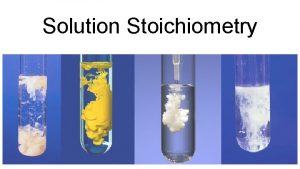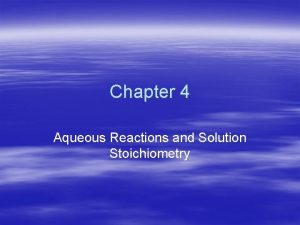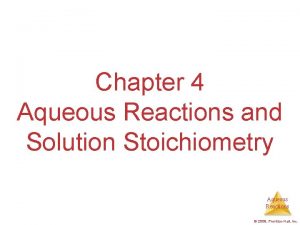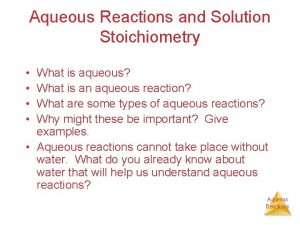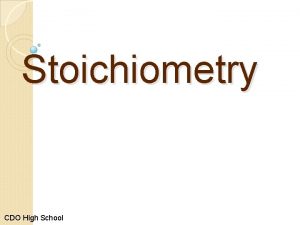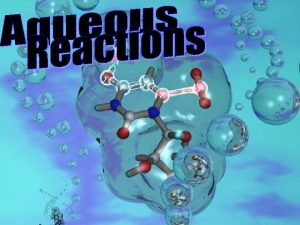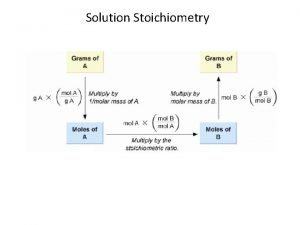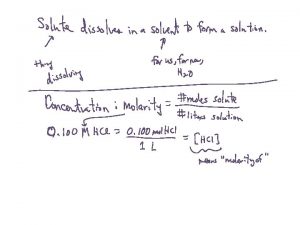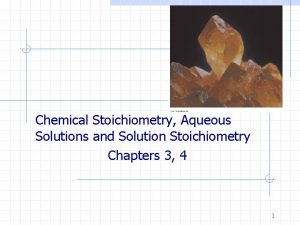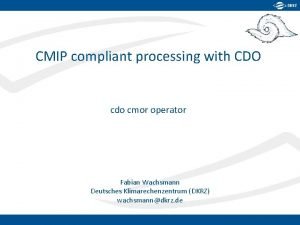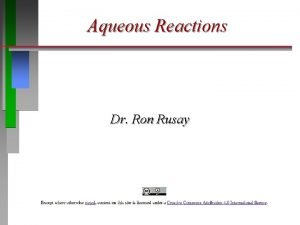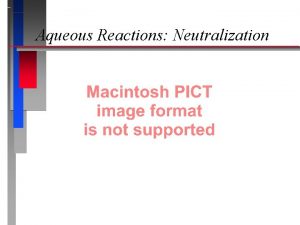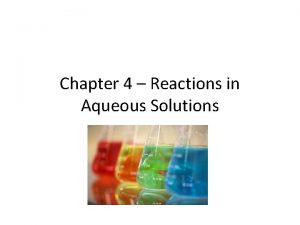Aqueous Reactions and Solution Stoichiometry CDO High School





















- Slides: 21

Aqueous Reactions and Solution Stoichiometry CDO High School Aqueous Reactions

Solute and solvent § Solute: the substance that is dissolved in another substance § Solvent: the substance that something is dissolved into it Aqueous Reactions

Concentrated vs Dilute § Concentration: refers to how much solute is dissolved in the solvent § Concentrated: solutions with a large amount of solute dissolved in solvent § Dilute: solutions with a small amount of solute dissolved the solvent Aqueous Reactions

Molarity § Two solutions can contain the same compounds but be quite different because the proportions of those compounds are different. § Molarity is one way to measure the concentration of a solution. moles of solute Molarity (M) = volume of solution in liters Aqueous Reactions

Units of Molarity 2. 0 M HCl = 2. 0 moles HCl 1 L HCl solution 6. 0 M HCl = 6. 0 moles HCl 1 L HCl solution Aqueous Reactions Lecture. PLUS Timberlake 5

Molarity Calculation Na. OH is used to remove potato peels commercially. If 4. 0 g Na. OH are used to make 500. m. L of Na. OH solution, what is the molarity (M) of the solution? Aqueous Reactions Lecture. PLUS Timberlake 6

Calculating Molarity 1) 4. 0 g Na. OH ÷ 40. 0 g/mol Na. OH = 0. 10 mole Na. OH 2) 500. m. L x 1 L _ = 0. 500 L 1000 m. L 3) 0. 10 mole Na. OH = 0. 20 M Na. OH 0. 500 L 1 L Aqueous Reactions Lecture. PLUS Timberlake 7

Learning Check M 1 Dr an o A KOH solution with a volume of 400 m. L contains 2 mole KOH. What is the molarity of the solution? Aqueous Reactions Lecture. PLUS Timberlake 8

Learning Check M 2 A glucose solution with a volume of 2. 0 L contains 72 g glucose (C 6 H 12 O 6). If glucose has a molar mass of 180. g/mole, what is the molarity of the glucose solution? Aqueous Reactions Lecture. PLUS Timberlake 9

Learning Check M 3 Stomach acid is a 0. 10 M HCl solution. How many moles of HCl are in 1500 m. L of stomach acid solution? Aqueous Reactions Lecture. PLUS Timberlake 10

Learning Check M 4 How many grams of KCl are present in 2. 5 L of 0. 50 M KCl? Aqueous Reactions Lecture. PLUS Timberlake 11

Solution M 4 3) 2. 5 L x 0. 50 mole x 74. 6 g KCl = 93 g KCl 1 L 1 mole KCl Aqueous Reactions Lecture. PLUS Timberlake 12

Learning Check M 5 How many milliliters of stomach acid, which is 0. 10 M HCl, contain 0. 15 mole HCl? Aqueous Reactions Lecture. PLUS Timberlake 13

Learning Check M 6 How many grams of Na. OH are required to prepare 400. m. L of 3. 0 M Na. OH solution? Aqueous Reactions Lecture. PLUS Timberlake 14

Solution Stoichiometry § The majority of work in research and industry involves solutions. Recall that solutions are easy to handle and are usually easier to control in reactions. § Solution stoichiometry – the procedure for calculating the molar concentration or volume of solution products or reactants Aqueous Reactions

XM rit y. A ola Molarity A (M) rity A A me olu ÷V XV o e. A m lu Mole A (mol) X Mole Ratio ÷M Mole B (mol) Mass B (g) Volume B (L) B rity a l o ÷ Molar Mass ola X Molar Mass ÷M X Molar Mass Volume A (L) ÷ Molar Mass A (g) y. B it lar Mo X ÷V olu m XV e. B olu me B Molarity B (M) Aqueous Reactions

Example #1 § Ammonia and phosphoric acid solutions are used to produce ammonium hydrogen phosphate fertilizer. What volume of 14. 8 M NH 3(aq) is needed to react with 1000 L of 12. 9 M of H 3 PO 4(aq)? § 2 NH 3(aq) + 1000 L H 3 PO 4(aq) x 12. 9 mol 1 L (NH 4)2 HPO 4(aq) x 2 mol ÷ 14. 8 mol/L = 1740 L 1 mol Aqueous Reactions

Example #2 § In an experiment, . 01000 L sample of sulfuric acid solution reacts completely with 0. 0159 L of 0. 150 M potassium hydroxide. Calculate the concentration of the sulfuric acid. § H 2 SO 4(aq) + 2 KOH(aq) 0. 0159 L x 0. 150 mol x 1 L 1 mol 2 H 2 O(l) + K 2 SO 4(aq) x 1 = 0. 119 mol/L 0. 0100 L Aqueous Reactions

Example #3 § How many grams of silver chromate will form when 120 m. L of 0. 500 M silver nitrate are added to potassium chromate? 2 Ag. NO 3(aq) + K 2 Cr. O 4(aq) Ag 2 Cr. O 4(s) + 2 KNO 3(aq) Aqueous Reactions

Example #4 § If you mix 200 ml of 0. 100 M Pb(NO 3)2 and 300 ml of 0. 200 M Mg. Cl 2, how much Pb. Cl 2 precipitate will you form? Pb(NO 3)2(aq) + 2 Mg. Cl 2(aq) Pb. Cl 2(s) + Mg(NO 3)2(aq) Aqueous Reactions

Move to slide 7 of Molarity dilution ppt Aqueous Reactions
 Aqueous reactions and solution stoichiometry
Aqueous reactions and solution stoichiometry Types of reactions
Types of reactions Types of chemical reactions and solution stoichiometry
Types of chemical reactions and solution stoichiometry Types of chemical reactions and solution stoichiometry
Types of chemical reactions and solution stoichiometry Reactions in aqueous solutions
Reactions in aqueous solutions Reactions in aqueous solutions practice problems
Reactions in aqueous solutions practice problems Chapter 4 reactions in aqueous solutions
Chapter 4 reactions in aqueous solutions Concentrated solution
Concentrated solution Chapter 4 reactions in aqueous solutions worksheet answers
Chapter 4 reactions in aqueous solutions worksheet answers Dilute solution
Dilute solution Cdo ensmean
Cdo ensmean Cdo valuation
Cdo valuation Synthetic cdo
Synthetic cdo Cdo valuation
Cdo valuation An artificial cell consisting of an aqueous solution
An artificial cell consisting of an aqueous solution Titrate
Titrate Monophasic liquid definition
Monophasic liquid definition Assume that an aqueous solution of a cation
Assume that an aqueous solution of a cation Stoichiometry map for chemical reactions
Stoichiometry map for chemical reactions Stoichiometry predicting amounts in reactions
Stoichiometry predicting amounts in reactions Section 2 classifying chemical reactions worksheet answers
Section 2 classifying chemical reactions worksheet answers What are redox reactions examples
What are redox reactions examples




